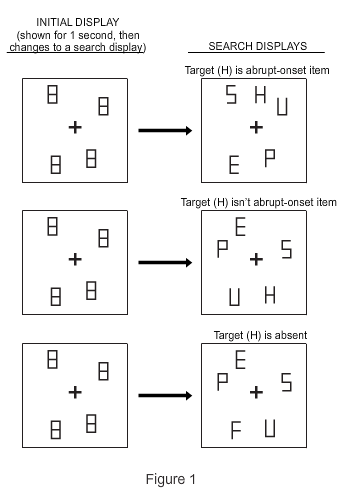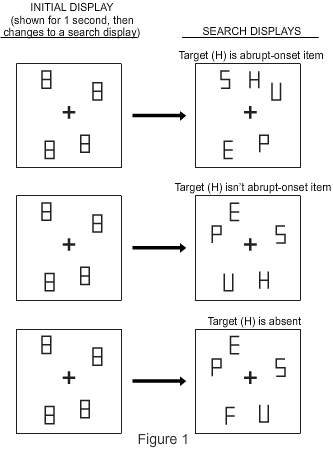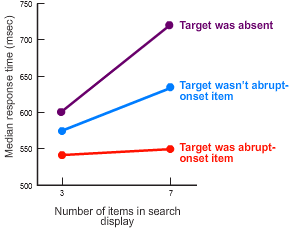Top-down attentional control involves deliberately paying attention to something in order to get information needed to achieve a goal. But bottom-up attentional control—which involves the involuntary, unavoidable capture of attention by a salient perceptual stimulus—is just as important, and in some situations more so. Sudden changes in the environment are often accompanied by salient perceptual stimuli and might well require a rapid response—for example, to avoid an approaching predator or to seize some passing prey. This kind of rapid, automatic response bypasses the relatively slow mechanisms for deliberately directing attention via top-down control.
The difference in speed between top-down and bottom-up attentional control was assessed in an experiment in which participants searched a display containing an array of letters for a particular target letter. In each display, one letter had an abrupt onset and was therefore perceptually salient. The other items were less salient because they didn’t have abrupt onsets. The participant had to press a button as quickly as possible after either finding the target or determining that is was absent. In each trial, the participant’s response time was measured. Figure 1 illustrates the three types of trials. Each trial begins with an initial display of block eights, which changes to a search display of letters in the same positions, but with an additional letter called the
abrupt-onset item. The participant searches this display for a target letter (H), which can be (1) absent, (2) present but not the abrupt-onset item, or (3) the abrupt-onset item.
When the target was present but wasn’t the abrupt-onset item, the response time increased as the number of letters to search increased (the search display could contain 3, 5, or 7 letters). This is what you’d expect if the participant has to evaluate each item separately, shifting attention from one to the next, until the target is found. In contrast, when the target was the abrupt-onset item, the response time was fast and didn’t increase as the number of letters to search increased. This suggests that the abrupt-onset item is frequently the first item to be searched, because its abrupt onset automatically captures the participant’s attention. Responses are slowest when the target is absent, because the participant has to check every item in the display to confirm that fact. These results show how bottom-up attentional control can produce a quick response to sudden events.

When the target was present but wasn't the abrupt-onset item, the response time increased as the number of letters to search increased (the search display could contain 3, 5, or 7 letters). This is what you'd expect if the participant has to evaluate each item separately, shifting attention from one to the next, until the target is found. In contrast, when the target was the abrupt-onset item, the response time was fast and didn't increase as the number of letters to search increased. This suggests that the abrupt-onset item is frequently the first item to be searched, because its abrupt onset automatically captures the participant's attention. Responses are slowest when the target is absent, because the participant has to check every item in the display to confirm that fact. These results show how bottom-up attentional control can produce a quick response to sudden events.






